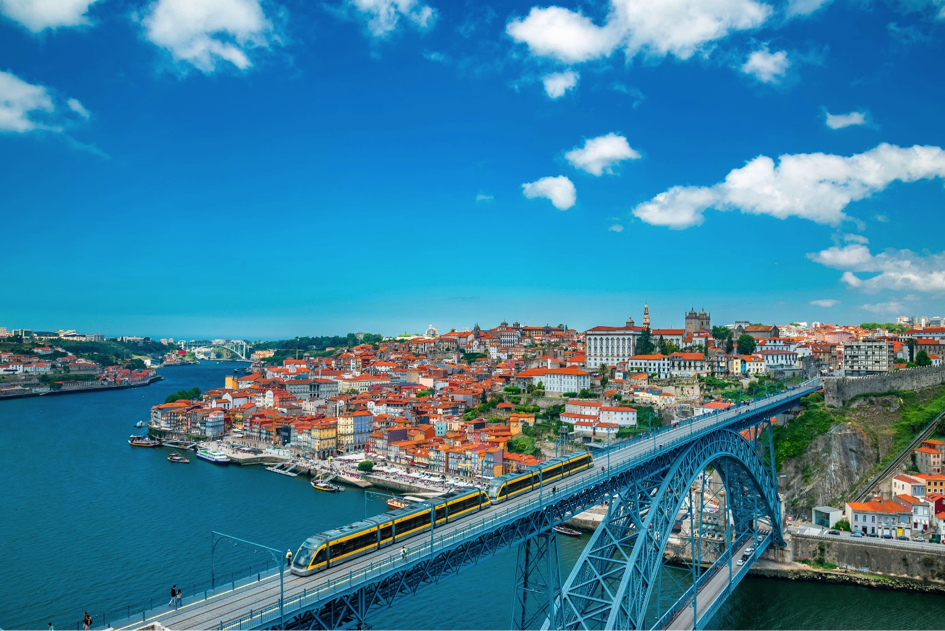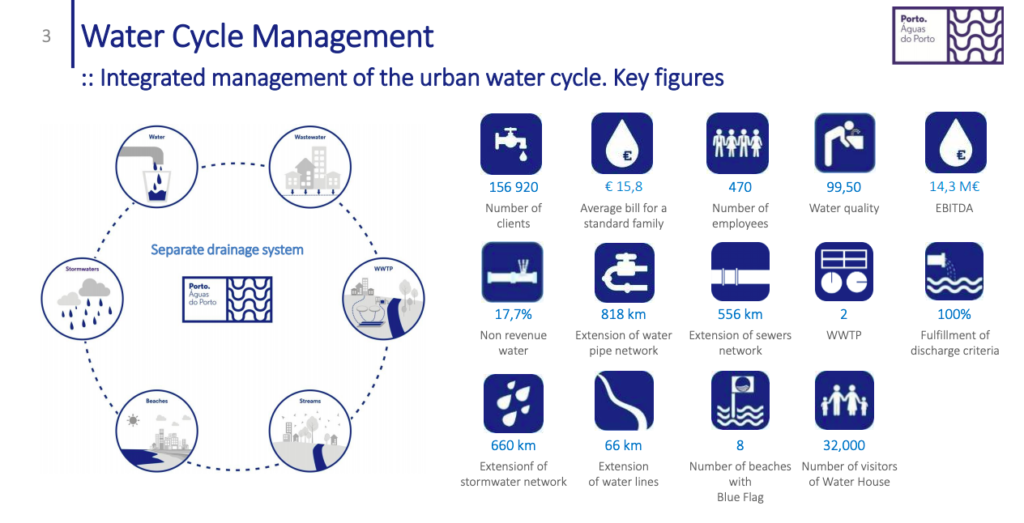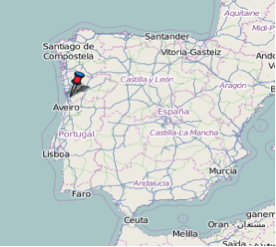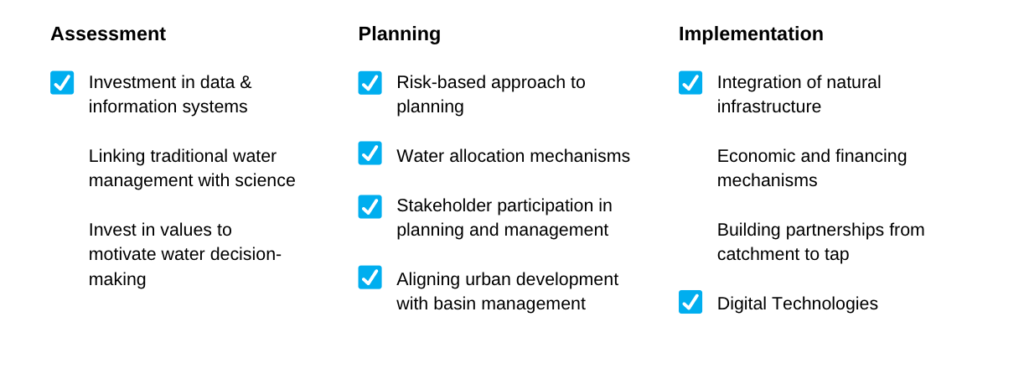Urban Water Cycle Integrated Management in Porto, Portugal
More than 75% of the streams and rivers in Porto are enclosed by pipes due to a variety of urban pressures ranging from infrastructure development to tourism. This has led to the degradation of the city´s ecosystems.
Águas do Porto, the utility responsible for urban water cycle management, has taken several measures to deal with ecosystem decline and prevent pollution, following the principles of River Basin Management Plans under the Water Framework Directive.
 This has included (1) prohibition of all new construction which involved covering or enclosing (with pipes) urban streams; (2) investment in the rehabilitation and re naturalisation of streams, using nature-based solutions (NBS); and (3) design and development of an innovative real time management platform for the full urban water cycle, which is named H2PORTO. This integrated management system helps to improve the efficiency of operation and maintenance activities in the water network, shifting away from the business-as-usual approach of asset management. With this innovative tool, Águas do Porto expects to anticipate and prevent pollution events in the urban streams, and consequently protect the watershed and ecosystems they rely on.
This has included (1) prohibition of all new construction which involved covering or enclosing (with pipes) urban streams; (2) investment in the rehabilitation and re naturalisation of streams, using nature-based solutions (NBS); and (3) design and development of an innovative real time management platform for the full urban water cycle, which is named H2PORTO. This integrated management system helps to improve the efficiency of operation and maintenance activities in the water network, shifting away from the business-as-usual approach of asset management. With this innovative tool, Águas do Porto expects to anticipate and prevent pollution events in the urban streams, and consequently protect the watershed and ecosystems they rely on.
Porto River Basin
1. The Problem
Management of the different stages of the water cycle for Porto was originally spread through various entities, resulting in significant inefficiencies in the way water was managed. However, in 2006, Águas do Porto was established as the municipal water utility to manage Porto’s water resources. The company manages more than 2,000 km of water infrastructure including water mains, sewers, and storm water pipes. Águas do Porto also manages 66 km of streams and 3.4 km of seafront, where more than half of which are bathing areas.
Rapid urban growth has led to significant pressures on water resources. More than 75% of the streams in Porto were piped and buried to allow construction of new buildings, leading to degradation of this water resources. This problem had persisted for decades, compromising the quality of life of the people living in Porto.
2. The solution – Working with stakeholders
Águas do Porto focuses on three main goals i.e. cleansing, day-lighting and rehabilitating Porto’s rivers and streams to establish a balance with the city’s natural resources. To achieve these goals, the utility, together with the Municipality, has designed and implemented sustainable strategies for the water resources in Porto.
First was the ban on all new construction covering or enclosing (in pipes) urban streams. Second was the use of innovative natured based solutions (e.g. re-naturing intervention through bioengineering solutions and ecosystem restoration practices) to rehabilitate local streams to enhance biodiversity, restore ecosystem services and improve human health, air and water quality.
The stream’s rehabilitation strategy developed in Porto was designed to complement the water sensitive urban design (WSUD) and improve the citizens´ quality of life. The main objectives of implementing NBS were:
- Stabilization of streams bed and banks to facilitate and promote natural development of the geomorphological processes (reducing erosion and flow control);
- Retention of (storm)water in the landscape and minimize flooding situations;
- Plant new trees in the streams banks and create new riparian zones with native species;
- Turn the riparian corridors accessible to the public through the adjoining public open space;
 The daylighting of three urban stream sections and the rehabilitation of the green corridors adjacent to them brought back the connection between water bodies and citizens, something that had been lost. These rehabilitation projects were also done considering the peak storm water flows, thus reducing the risks of flooding. With one of the interventions, the stream daylighting allowed to create a large retention basin to accommodate the excessive flow and therefore contributed to minimize frequent flooding problems.
The daylighting of three urban stream sections and the rehabilitation of the green corridors adjacent to them brought back the connection between water bodies and citizens, something that had been lost. These rehabilitation projects were also done considering the peak storm water flows, thus reducing the risks of flooding. With one of the interventions, the stream daylighting allowed to create a large retention basin to accommodate the excessive flow and therefore contributed to minimize frequent flooding problems.
Thirdly, in 2016 Aguas do Porto launched the design and development of an innovative real time management platform for the full water cycle, the H2PORTO. This platform incorporates all data gathered in-house from meters, sensors, operations and SCADA systems as well as external sources, such as weather stations and traffic control systems. The H2PORTO platform relies on organising data spread in several data bases, providing communication amongst other technological platforms, business intelligence tools, and decision making through the analysis of data, modelling tools and predictive analysis and strives to provide information to its citizens.
The development of this integrated management system improved Águas do Porto’s efficiency around operation and maintenance activities in their water networks, changing the asset management approach to proactive rather than reactive thereby, preventing pollution events in the urban streams to protect the watersheds and their ecosystems.
Águas do Porto – H2 Porto from João Castro on Vimeo.
Having the support of partners and key stakeholders has been an important element of success in implementing these solutions. Águas do Porto works closely with the Municipality of Porto and the Portuguese Environment Agency for all urban planning and key decisions regarding the daylighting of streams. Working closely with owners of adjacent lands is also a key action.
3. Lessons Learned
Integrating data in a technological platform management system has provided the utility with a useful tool that has improved and made water service provision more reliable while also achieving a more structured and effective communication and collaboration process, both internally and externally.
Despite the ongoing development, the H2PORTO platform has allowed the introduction of mobile devices for operational employees to register the details of their interventions and to expedite communications. This has helped to eliminate redundancies. The design and development stages of this tool is promoting improvements and changes in internal processes of operation and maintenance and encouraging the improvement of tasks that were hindered by obsolete habits and routines. The inputs and involvement of operational employees were fundamental to create an application that better serves their daily work.
What are the drivers for action?
For more information on the Drivers for Action visit the Action Agenda for Basin-Connected Cities.
Pathways for Action
For more information on the Pathways for Action visit the Action Agenda for Basin-Connected Cities.
4. Useful links and resources
List of useful links providing additional information:
Águas do Porto website: http://www.aguasdoporto.pt [in Portuguese]
Águas do Porto Annual Report for 2016 [in Portuguese]
Porto Municipal Environmental Strategy [in Portuguese]
Municipality of Porto Tourism Portal.
PwC Portugal Presentation about Tourism in Porto (forecast for 2017-2018) [in Portuguese]
PwC Report ‘European Cities Hotel Forecast for 2017 and 2018’
About the contributor
Águas do Porto is a municipal responsible for the integrated and sustainable management of the urban water cycle in the city of Porto. Find out more here: www.aguasdoporto.pt [in Portuguese].





